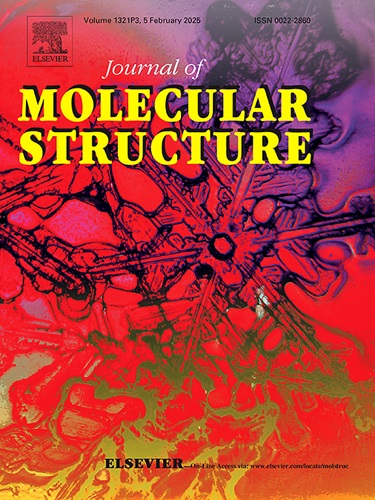Benzimidazolone conjugated biscoumarins: Synthesis, molecular docking studies, urease, lipase, and acetylcholinesterase inhibitory activities
IF 4
2区 化学
Q2 CHEMISTRY, PHYSICAL
引用次数: 0
Abstract
New biscoumarin molecules bridged benzimidazolone were synthesized and then screened for their urease, lipase, and acetylcholinesterase inhibition properties. In this series, the best urease inhibition value belongs to compound 4f (IC50: 0.05 ± 0.003 μM), the most effective lipase inhibition was shown by the compound 4s (IC50: 0.05 ± 0.014 μM). Although the inhibition value of all compounds against acetylcholinesterase is remarkable, compound 4e showed the closest inhibition to tacrine (IC50: 0.031 ± 0.013 μM) with an IC50 value of 0.096 ± 0.018 μM. Molecular docking studies were performed using the Schrödinger Suite package using the IFD protocol to elucidate the interaction mode of the synthesized compounds with the binding site of urease, lipase and acetylcholine esterase enzymes. The molecular docking studies supported the in vitro inhibition results. It was shown that the compounds interacted with the important residues of the active site of the enzymes through hydrogen bonding, π–π stacking and hydrophobic interactions. 100 ns Molecular Dynamics (MD) simulations were performed on the top docking-scored complex to evaluate the stability of the ligand–protein interactions. The ADMET profiles of the most potent compounds were also evaluated to assess their pharmacokinetic and toxicity characteristics.

苯并咪唑酮偶联双香豆素:合成、分子对接研究、脲酶、脂肪酶和乙酰胆碱酯酶抑制活性
合成了新的桥接苯并咪唑酮双香豆素分子,并对其抑制脲酶、脂肪酶和乙酰胆碱酯酶的性能进行了筛选。其中化合物4f对脲酶的抑制效果最好(IC50为0.05±0.003 μM),化合物4s对脂肪酶的抑制效果最好(IC50为0.05±0.014 μM)。虽然所有化合物对乙酰胆碱酯酶的抑制作用都很显著,但化合物4e的IC50值为0.096±0.018 μM,与他林的IC50值最接近(0.031±0.013 μM)。使用Schrödinger Suite软件包,采用IFD协议进行分子对接研究,阐明合成的化合物与脲酶、脂肪酶和乙酰胆碱酯酶结合位点的相互作用模式。分子对接研究支持体外抑制结果。结果表明,化合物通过氢键、π -π堆积和疏水相互作用与酶活性位点的重要残基相互作用。对对接得分最高的配合物进行了100 ns分子动力学(MD)模拟,以评估配体-蛋白相互作用的稳定性。对最有效的化合物的ADMET谱也进行了评估,以评估其药代动力学和毒性特征。
本文章由计算机程序翻译,如有差异,请以英文原文为准。
求助全文
约1分钟内获得全文
求助全文
来源期刊

Journal of Molecular Structure
化学-物理化学
CiteScore
7.10
自引率
15.80%
发文量
2384
审稿时长
45 days
期刊介绍:
The Journal of Molecular Structure is dedicated to the publication of full-length articles and review papers, providing important new structural information on all types of chemical species including:
• Stable and unstable molecules in all types of environments (vapour, molecular beam, liquid, solution, liquid crystal, solid state, matrix-isolated, surface-absorbed etc.)
• Chemical intermediates
• Molecules in excited states
• Biological molecules
• Polymers.
The methods used may include any combination of spectroscopic and non-spectroscopic techniques, for example:
• Infrared spectroscopy (mid, far, near)
• Raman spectroscopy and non-linear Raman methods (CARS, etc.)
• Electronic absorption spectroscopy
• Optical rotatory dispersion and circular dichroism
• Fluorescence and phosphorescence techniques
• Electron spectroscopies (PES, XPS), EXAFS, etc.
• Microwave spectroscopy
• Electron diffraction
• NMR and ESR spectroscopies
• Mössbauer spectroscopy
• X-ray crystallography
• Charge Density Analyses
• Computational Studies (supplementing experimental methods)
We encourage publications combining theoretical and experimental approaches. The structural insights gained by the studies should be correlated with the properties, activity and/ or reactivity of the molecule under investigation and the relevance of this molecule and its implications should be discussed.
 求助内容:
求助内容: 应助结果提醒方式:
应助结果提醒方式:


